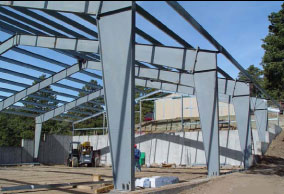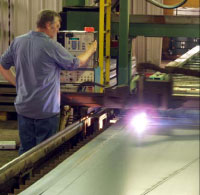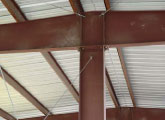ARMOR'S PRIMARY FRAMING
MATERIALSHaving a Strong, properly designed, engineered and fabricated support of your building's primary framing is the first critical step to a Quality building. Our rigid frame beams are made of minimum 50,000 PSI steel plates of ¼" thick or greater for the manufacture of the beams that are the Primary support for your building. This much higher tensile strength steel allows for a stronger support beam to meet high snow and wind loads, while at the same time requiring less depth in the beam due to the additional strength. This provides you much better clearance inside your building under the haunch, or bottom of the connection of the rafter and column. COMPETITION: Many Competitors use 36,000 PSI materials in 3/16" thick steel plates. The 36,000 psi material will weigh more and require a much deeper steel beam to acquire the same snow and wind loads due to the lower quality product, which uses up your clearance under the haunch of the beam. So, don't be fooled by "puffed" weights of the building. The building weighing more may be an indicator of lower quality materials.  EQUIPMENTThe rigid frames are solid steel I-beams. A cross section of the frames look like the letter I. The outside of the I is the flanges while the inside of the I is the web. The flanges on the roof rafters and the side columns are pre-punched by a sophisticated computer aided flange line that punches precise holes in the flanges so that the purlins and girts can be bolted directly to the rafters and columns with A307 hi-grade bolts for secondary connections, with A325 bolts for the connections of Primary Framing. This gives you the strongest connection from your primary main support beams and secondary purlins and girts as possible. The webs are cut with a computer aided plasma cutter that cuts the webs from the steel plates with the greatest precision available which allows for a precise fit when the webs and flanges are welded into the I shape. COMPETITION: Many competitors do not having the sophisticated computer aided plasma cutters or flange lines to pre-punch the holes in the rafter and column flanges and as a result are required to torch the holes into the flanges or have small brackets or clips that they weld to the flange with only 2 small spot welds to tack them to the rafters and columns. As a result these "factory welded clips" are subject to be broken off during erection and shipping, and many times due to hand welding are not welded in the precise location and are easily knocked off. This causes undue down-time and labor to re-weld. These clips are popular among the "frame shops". Some even use open web truss type systems very similar to wood trusses that are steel with small 11/4 " flanges and steel rods welded together to make a rafter or column. These are very cheap and do not have the same structural integrity as a solid steel I-beam. WELDINGThe flanges and webs that make the I-beams are welded together by some of the most sophisticated, computer aided, automatic submerged arc welded machines in the industry. This expensive equipment reduces the chance of human error as well as provides the most stringent quality control and uniform welds available in the industry. This equipment and the Quality control allow the welds to meet or exceed industry standards such as AISC, MBMA and ICBO standards. The submerged arc welds allow for a much more even temperature which allows the ¼" and thicker material to withstand the heat of automatic welders without the welds becoming brittle, cracking, bowing or warping the beam which would make it extremely difficult to erect.  COMPETITION: Many competitors, due to the high cost of the sophisticated and high quality equipment, still use hand or "spot" welds or portable Mig welders to weld the flange and webs together. These types of welds allow for many errors as well as make it difficult to meet strict quality control programs which are required by most building departments. The thin material can warp if the welding temperature is too high. The result is a bowed or warped beam which is extremely difficult to erect and will not maintain the same structural integrity. PRIMERArmor Buildings have a "Master Grey" primer coating sprayed on the beams after the fabrication process has been completed which provides a primer to protect the beams from rust during shipping. The light grey primer also allows the finished building a much lighter and brighter interior to compliment the shiny galvanized purlins and girts.  COMPETITION: Some Competitors have no primer or a dark red primer that in some cases was sprayed on before they purchased the beams and torched the holes for the bolt connections into the beams. The dark red primer absorbs much of the light on the interior and gives a much darker appearance requiring more lighting to brighten the interior. |